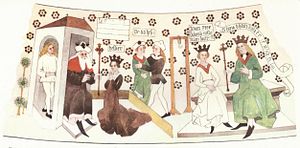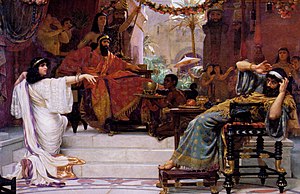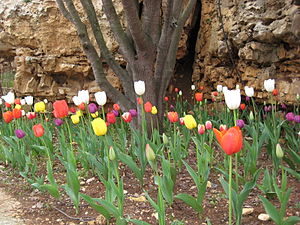It’s Purim – and everything is hafuch – upside down. This guy will only be around for the holiday!
Rabbi Ruth Adar will return on the 15th of Adar.

Esther 3:1 After these things, Ahasuerus promoted Haman the son of Hammedatha the Agagite, and elevated him, and set his seat above all the nobels that were with him.
The Book of Esther doesn’t say why Ahasuerus promoted Haman, the bad guy of the story. What the book does say is that he was the son of an Agagite, which provides a link back to Israel’s Biblical enemy, Amalek.
Agag, the king of Amalek, appears first in the blessing of Balaam (Numbers 24:7) but he comes up again and again, finally to war again with Israel and be killed off by the prophet Samuel in 1 Samuel 15. Amalek was an enemy we first encountered in the wilderness, where that nation preyed upon the stragglers on the margins of the camp (Exodus 17: 8-10). At the end of that chapter, God says to Moses:
Write this for a memorial in the book, and rehearse it in the ears of Joshua: for I will utterly blot out the remembrance of Amalek from under heaven.
This verse makes a puzzle: how can we memorialize Amalek, rehearse the story of Amalek, but utterly blot out remembrance of Amalek?
First, and simplest, this is why we boo and make the groggers roar at the name of Haman. We are “blotting out” his name.
But more importantly, this is a warning about all the enemies to come in Jewish history as it unfolds, whether it is Rome, or Ferdinand & Isabella of Spain, or Hitler. On the one hand: don’t forget. And on the other hand: don’t give these guys too much attention. Don’t reduce Judaism to ONLY remembering.
Purim reminds us that as long as we are here to celebrate it, Amalek has not prevailed. So yes, we remember all the stories from the bad old days, but also we live vital lives of Torah in the here and now. The Holocaust is important to remember, but it is also important not to make it the sum total of our identity as Jews. We are more than what has been done to us.
I’d say that’s something to celebrate.

Adar is the month of fun – warm up for Purim by watching some of the great videos available on the Net:
The Book of Purim: Official Parody of The Book of Mormon – Hebrew Union College Year in Israel Class 2011-12.
Move Like Graggers Remix – Temple Israel of West Bloomfield, MI
Purim Song – The Maccabeats
Raise Your Mask Purim – Ein Prat Fountainheads, students at Midreshet Ein Prat, Israel
Purim Story – Shalom Sesame
Haman Song: Purim Rap – hypersemitic
Have fun! If you know of other good ones, post them in the comments!

If you are new to synagogue, Purim is either a treat or a shock, maybe both. It’s a holiday based in the Biblical book of Esther, which is such a wild, farcical document that it very nearly didn’t get included in the Bible. Here’s what you need to know:
1. WHEN? Purim falls on 14 Adar. In a leap year, it falls on 14 Adar II. There may be something called Shushan Purim on your Jewish calendar, but you only need to worry about it if you live in a walled city such as Jerusalem. For conversion to the secular calendar, check a Jewish calendar.
2. THE STORY For the whole megillah [scroll] read the Book of Esther in the Bible. The short version: The Jewish community in Persia is nearly annihilated when King Ahasuerus’s chief minister, Haman, takes a dislike to them. The king’s queen, Esther, is secretly a Jew and she intervenes to save the day. The full story, in the Bible, is at least R-rated for both sex and violence, but in most American synagogues what you will hear is the G-rated version edited for children’s ears.
3. MITZVAH 1 – HEAR THE STORY. We are commanded to hear the story every year. We fulfill that mitzvah either by hearing the scroll chanted or by seeing it acted out in a Purim Shpiel, with lots of audience participation. It is traditional to drown out the name of the villain, Haman, with noisemakers like groggers or with boos.
4. MITZVAH 2 – FESTIVE BANQUET. We are commanded to enjoy a festive meal on Purim. One theme for the holiday is feasting – if you read the story, you’ll notice there are lots of parties in it. Hamentaschen are three-cornered filled cookies associated with the holiday.
5. MITZVAH 3 – GIFTS TO POOR PEOPLE. We are commanded to see to it than even the poorest people can enjoy a festive meal – hence, gifts of food to the poor. (A donation to the Food Bank in your area works nicely.)
6. MITZVAH 4 – MISHLOACH MANOT (Meesh-LOW-ach man-OAT) are small gifts of baked goods, wine, or other goodies, given to friends to enhance their feasting. Ideally they are a little package of more than one goodie.
7. COSTUMES. Many Jews, both children and adults, wear costumes to synagogue for the Purim festivities. Often people dress as characters from the Purim story, but pirates, astronauts, and superheroes are good, too. Some just wear a mask for Purim, because one of the themes of the holiday is secret identities.
8. DRINKING. There is a tradition that one should drink “until one cannot tell Haman from Mordechai” – the bad guy from the good guy. This, too, is a theme from the story but it has too often been taken to excess. Don’t drink and then drive home from synagogue, or push alcohol on anyone, please. No matter what anyone tells you, getting drunk is never a mitzvah.
I have noticed in the past few days that suddenly lots of people are looking to Google for help preparing for Passover.

“Mishenichnas Adar marbin b’simchah” B.Ta’anit 29a
“When Adar enters, joy increases.”
Today is Rosh Chodesh Adar, the beginning of the month of Adar. Adar is the month of Purim, of good luck, of silly games and pranks. We are commanded to “increase joy” although we are not given any direction about how to go about it.
I have quoted the line above from Ta’anit many times, but I realized I’d never studied it and had no idea about the context. Today I went to take a look:
“Ta’anit” means “fasts.” This masechet [book] of the Babylonian Talmud is a compilation of discussions about fast days (with, of course, digressions on those discussions.) Fast days are somber occasions: Yom Kippur [The Day of Atonement] and the Ninth of Av [the memorial of the destruction of the Temple] are the best-known fast days. They are not happy occasions. How did this line about Adar wind up in there?
Sure enough, when I looked it up, the rabbis are in the midst of a sobering discussion about the “curtailment of rejoicings” in the month of Av. There’s a heartbreaking story about the young priests going to the roof of the Temple as it was burning, reaching their arms up to throw the Temple keys into the hands of the angels. Then the young priests, their duty done, fall into the fire. There is a sad quotation from Isaiah about people dying, and God weeping.
Then a new bit of Mishnah is quoted: “WITH THE BEGINNING OF AV REJOICINGS ARE CURTAILED.”
And the Gamara expounds upon it:
Rab Judah the son of R.Samuel b. Shilath said in the name of Rab:
Just as with the beginning of Ab rejoicings are curtailed, so with the beginning of Adar rejoicings are increased.
R. Papa said: Therefore a Jew who has any litigation with Gentiles should avoid him in Ab because his luck is bad and should make himself available in Adar when his luck is good.
To give you a future and a hope:
Rab Judah the son of R. Samuel b. Shilath said in the name of Rab: By this is meant [an abundance of] palm trees and flaxen garments.
And he said: See, the smell of my son is as the smell of a field which the Lord hath blessed:
Rab Judah the son of R. Samuel b. Shilath said in the name of Rab: As the smell of an apple orchard.
… and then the text returns to the grave discussion of the “curtailment of rejoicings” of the month of Av.
There are many possible ways to read this, but what I take from it is that the sadnesses of life are simply facts. There is tzuris [trouble] in every life. But just as this discussion of Adar bursts in upon the discussion of tzuris for a moment, so does the month of Adar burst in upon us in the wettest, most bedraggled bit of winter. Good surprises burst in upon tired routine: sometimes instead of bad luck, we have good luck. Sometimes a new baby is born, and he smells wonderful. The message: if we are truly devout, we will remain open to the possibilities of those moments.
Adar comes with a command to “increase joy.” To do that, we must stay attuned to the possibility of the sacred moment when laughter breaks through tears, sun through clouds, beauty through the gray winter. If we are paying attention, we will be awake for joy. Adar is the month to cultivate that sacred skill in ourselves. For indeed:
Days pass and the years vanish, and we walk sightless among miracles. Lord, fill our eyes with seeing and our minds with knowing; let there be moments when Your Presence, like lightning, illumines the darkness in which we walk.
Help us to see, wherever we gaze, that the bush burns unconsumed.
And we, clay touched by God, will reach out for holiness, and exclaim in wonder:
How filled with awe is this place, and we did not know it! Blessed is the Eternal One, the holy God! [Gates of Prayer]
Happy Adar! May your joy increase, and may you be awake to it!
May it give you “a future and a hope.” Amen.

In a few days we will celebrate Tu B’Shevat (in 2013, it begins the evening of January 25). Here are the basics:
1. THE NAME. “Tu B’Shevat” means “15th of Shevat.” Tu is a way of pronouncing the letters that make up the number 15 in Hebrew. (For more about Hebrew numbers, check out this article in Wikipedia.) Shevat is the month in the Jewish calendar that includes the deep winter in Israel, generally January and a bit of February.
2. ORIGINAL MEANING. Tu B’Shevat is often referred to as the “New Year for Trees.” But didn’t we already celebrate a New Year at Rosh HaShanah? This is the beginning of a fiscal year for agricultural accounting in the Land of Israel. Originally, it was a calendar date at which farmers began counting the year for trees, so that they’d know when trees were old enough to reap the fruit according to Jewish Law (Leviticus 19:23-25), and the point from which tithes could be calculated. At this time of year, the trees are either dormant or just beginning to blossom.
3. MYSTICAL MEANINGS. After the Jews were expelled from Spain in 1492, some traveled east to the land of Israel. Most settled in and around the town of Safed, in the northern Galilee, which became a center for Jewish mysticism (kabbalah.) These mystics began to mark the holiday with a seder (ritual meal eaten in a particular order) somewhat like the Passover seder. At a Tu B’Shevat seder, four cups of wine are drunk and seven different kinds of fruit. The seder was a celebration of rededication to the Land of Israel and an appreciation of its trees.
4. ZIONIST MEANINGS. With the return to the Land of Israel in the 19th and 20th centuries, Jews revived the observance of Tu B’Shevat as a rededication to the land and a celebration of the relationship between Jews and this particular plot of earth. Many Jews worldwide observed the custom of planting trees in Israel, to replace trees that had been stripped from the land during the Ottoman period.
5. JEWISH EARTH DAY. In the late 20th century, as concern for the environment has grown, Tu B’Shevat has taken on more meaning as a day for Jews to express their concern for ecological issues. The Tu B’Shevat seder has been revived as not only a celebration of the Land of Israel and its trees, but as a celebration of the holiness of the earth and its creatures.
Image: A menorah, lit for the 4th night of Hanukkah
Hanukkah is coming! Rather than write a redundant “how-to” post, here are resources from around the web for celebrating the holiday.
How to Light the Menorah:
In the video, Rachael talks about the nine candles being on the same level. That’s the most common arrangement and according to some sources, the most correct one. However, some artists have made chanukiot (menorahs) with candles at many different levels. To find the shamash [helper candle] on those, look for the one that stands out in some way.
What to Eat:
This holiday, like many holidays, has special foods. Since one of the Hanukkah stories is a story about oil, it’s traditional to eat fried foods. Ashkenazim (Jews of Eastern European descent) eat latkes, potato pancakes:
Sephardim and Mizrachim, Jews of Spanish or Eastern descent, eat Sufganiot, a fried pastry like jelly doughnuts:
I’m a Jew who grew up in the American South, so I make Hush Puppies for my family (this is not a tradition except in my house, but I offer it to you. Hush Puppies are delicious and are fried in oil, which makes them Hanukkah-appropriate.)
Songs to Sing
We are supposed to stop work and celebrate Jewish culture while the lights are burning. I’m going to leave you a project for this one: go to youtube.com and search on Hanukkah and see what you find!
How to Play Dreidel
The Story (Stories!) of Hanukkah
This holiday has some interesting stories and ideas connected with it. This article from MyJewishLearning.com will get you started.
How To Spell Hanukkah
The correct way to spell Hanukkah is חנכה. If you transliterate the word (change the Hebrew letters to Latin letters) then it can be spelled many ways: Hanukkah, Chanukah, Chanukka, etc. In other words, it’s a hard word to spell, and a harder word to mis-spell.
How are you going to celebrate חנכה this year?
A few basic facts about the holiday:
WHAT IS SIMCHAT TORAH? Simchat Torah – “Joy of the Torah” – is the festival marking the day that we finish reading the Torah scroll and begin reading again from the beginning.
WHEN DO WE CELEBRATE SIMCHAT TORAH? This holiday falls immediately after Sukkot in the fall.
HOW DO WE CELEBRATE? Celebrations begin during the evening service. We take out the Torah scrolls and parade them around the synagogue in seven hakafot [Torah processions.] We sing about the Torah, and may dance with the Torah scrolls. Children carry special “Simchat Torah flags” (see the example above) and may also receive candy. After the dancing, Torah readers read from the end of the scroll, and then from the beginning of the scroll.
WHERE DO WE CELEBRATE? Simchat Torah is celebrated mostly at the synagogue.
WHAT’S THE POINT? The Torah is the most precious possession of the Jewish People. We’ve had it for thousands of years. Many Jews spend their lives studying it, reading it, arguing about it, and struggling with it. When we come to the end of the scroll, we celebrate the fact that once again, we have read the whole scroll, and even more, once again we are beginning again. Our love affair with the Book never ends.